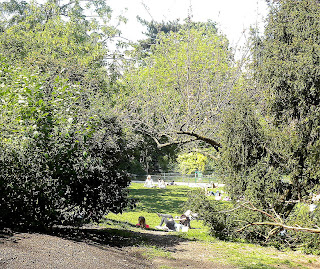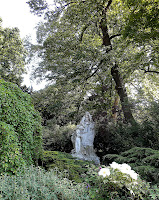Not only is it family friendly, but it also contains the history of several centuries of Paris in a nutshell.
There are four ways into to the Parc Monceau but I usually use the majestic main entrance.

Two sand and gravel “allées” bisect it.

There is also a circular path around the outer edge and, within the circle, smaller paths which make you forget how close the city traffic is.

Lining all these paths are green benches. People sit snoozing or reading Kant, the latest Danielle Steele or Paris Match according to tastes. Families or friends in twos and threes enjoy the fresh air, the flowers, the trees, the latest gossip – or the free WiFi.

In the areas between the paths, groups of families and friends relax on the grass – a triumph of democracy. Until a few years ago, the disapproving residents of the elegant apartment buildings that surround the Parc required guards to patrol regularly, moving people on. A compromise was eventually reached. From October until April the grass “rests”. From April until October more modest apartment dwellers can enjoy the soft green carpet.





The Parc Monceau is the neighborhood children’s “back yard.




Another attraction is the duckpond.

But I promised you history, so let us stroll through the Parc again,looking with different eyes.
Beside the main gates, there is a large stone rotunda, prosaically housing the public restrooms.

Its past was grander. This is one of the few remains of the Wall of the Farmers General which surrounded Paris until the French Revolution. Unlike today’s gardeners

these “farmers” had no tractors or hoes. They were tax collectors. Anyone desiring to enter Paris with merchandise had to pay tax at places like our rotunda. The wall has long since disappeared but the tax was only abolished in 1948.
I used to wonder how old the park was. A pyramid stands next to one of the walkways

and the ruins of a Greek temple partially surrounds the duck pond.

But, I found out,these are just an architect’s nod to exoticism as are the romantic grotto, bridge and waterfall in the Parc's heart.




Louis XVI’s cousin bought this land in 1769 in what was then a pleasant country area just outside Paris. He continued enlarging and improving his private park until 1778. When the French Revolution began, it was declared a National Treasure and became the scene of popular fairs and entertainments.
In the southeast corner of the Parc, a small plaque commemorates the world’s first successful parachute jump. On 0ctober 22nd 1797, just about the time that Napoleon I was coming to power, André Jacques Garnerin, a Parisian military man, jumped from a hot air balloon at
The city of Paris acquired the Parc in 1860 – smaller the original since half the land had been returned its original owners – but enough to allow us city-dwellers to enjoy a sunny day.
























